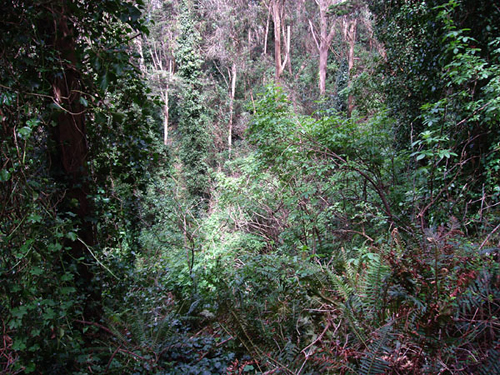UCSF Issues Report Documenting Extensive Community Involvement in Mount Sutro Planning

A report documenting the extensive community involvement that UCSF facilitated in 2009-2010 to develop forest management goals for the Mount Sutro Open Space Reserve and how the University will implement them is now available to the UCSF community and the general public.
The Community Planning Process Summary Report is posted on the UCSF Community & Governmental Relations website.
The report is produced by MIG Inc., a Berkeley-based firm specializing in planning, designing and sustaining environments in projects that encourage community and stakeholder interaction. UCSF has retained MIG as consultants and has worked with MIG principal Daniel Iacofano for 18 years to foster community outreach and involvement for several projects.
Located above the UCSF Parnassus campus, the Mount Sutro Open Space Reserve is University property and is comprised of 61 acres of open space. Due to the proximity of the Reserve to the campus and residents, preserving and maintaining the unique urban area is important to both UCSF and the broader community.
The purpose of the community planning process was to define areas where “best practices” in forest management could be demonstrated and evaluated. These demonstration areas would allow for input from the campus and community prior to any further steps being taken.
“The community planning process allowed us to hear from a broad representation of the community and to tailor a plan to showcase various forest management practices,” said Barbara J. French, vice chancellor for Strategic Communications and University Relations. “Our aim is to make sure we are maintaining this treasured open space area in a responsible manner that is responsive to community needs and campus needs.”
Community Input on EIR Sought
UCSF encourages community involvement in preparation for the Mount Sutro Environmental Impact Report (EIR). An EIR scoping meeting is scheduled for:
Monday, Jan. 10 at 7 p.m.,
UCSF Millberry Union,
500 Parnassus Ave.
The Community Planning Process Summary Report outlines several changes that were made to the demonstration project plan as a result of the community’s engagement and input over the year-long planning process, and also contains commitments that UCSF will follow going forward.
Importantly, the report includes more opportunities for community involvement throughout the entire environmental impact review (EIR) process as required by the California Environmental Quality Act.
An EIR scoping meeting is scheduled for Monday, Jan. 10 at UCSF to provide an opportunity for the community to discuss the scope and content of the environmental information they expect to see included in the draft EIR. This allows UCSF to learn about potential concerns early, as well as further define the issues, feasible alternatives, and potential mitigation measures that may warrant in-depth analysis in the environmental review process. The draft EIR is expected to be published in Spring 2011.
An initial environmental study will be available online on the UCSF Campus Planning website by Dec. 10. The initial study includes a project description and discusses potential environmental impacts and proposed mitigation measures for any significant effects. It also identifies the scope and content of the environmental information that will be included in the draft EIR.
Commitment to Safety, Sustainability
UCSF has a strong commitment to ensuring that the Reserve is safe and sustainable so that neighbors, visitors and the UCSF community may enjoy it. This commitment dates to UCSF’s 1996 UCSF Long Range Development Plan (LRDP). In response to well-documented community concerns, the LRDP recommended that UCSF investigate an appropriate maintenance and restoration program for vegetation and to improve hiking trails on Mount Sutro.
The LRDP recommendations led to an extensive planning process, which included four years of community consultations and nine community meetings. The process produced the Mount Sutro Open Space Reserve Management Plan in September 2001, which integrated neighborhood interests and UCSF concerns based on seven planning principles, or goals:
- Ensure public safety and property protection;
- mprove the health of the forest;
- Protect and expand native plants;
- Enhance wildlife habitat values;
- Maintain scenic quality;
- Improve public access; and
- Implement the Resource Management Plan.
In an effort to continue to advance the 2001 plan, and in response to community concerns about UCSF’s application for funding from the Federal Emergency Management Agency (an application that was ultimately withdrawn), UCSF reached out to neighbors for input and guidance. The focal point of this year-long planning process was two-fold:
- To identify best practices in urban forest management that promote safety, enhance health and aesthetics and contribute to usability, and
- To identify specific, limited areas within the Reserve to demonstrate these practices.
The overarching goal was – and remains – to collaborate with the community to identify, demonstrate and evaluate best practices before any further decisions or actions are taken.
In May, June and July, UCSF held three community workshops. Before each community workshop, a small representative group of neighbors met with UCSF staff to plan the workshop agenda. During each workshop, community issues and concerns were discussed as they related to potential demonstration projects and evaluation criteria.
Four demonstration projects on less than 7.5 acres are proposed for implementation in the Reserve. The projects were designed with different characteristics to allow for evaluation of varying management techniques.
This process has served to better inform and engage the community, which is reflected in the resulting Community Planning Process Summary Report. This report outlines a thoughtful and measured approach toward the implementation of forest management practices in the specific, limited demonstration areas.
“UCSF would like to thank all those who participated in the 2009-2010 Community Planning Process,” said Barbara Bagot-Lopez, director of Community Relations at UCSF. “The community’s continued participation is appreciated and valued as we seek to maintain and manage this treasured open space.”
Mount Sutro Open Space Reserve Community Planning Process Summary (2010)
- Low-resolution, optimal for on-screen viewing [PDF]
- High-resolution, high print quality—will take longer to download [PDF]
Related Links:
UCSF Community and Governmental Relations
UCSF Video Depicts Story of Mount Sutro
UCSF Today, August 31, 2010